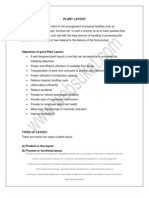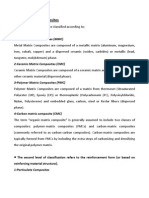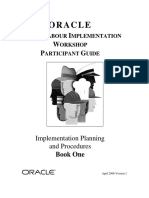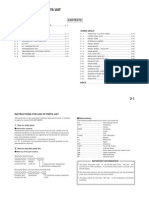Introduction To Materials Handling PDF
Introduction To Materials Handling PDF
Uploaded by
hijzainCopyright:
Available Formats
Introduction To Materials Handling PDF
Introduction To Materials Handling PDF
Uploaded by
hijzainOriginal Description:
Original Title
Copyright
Available Formats
Share this document
Did you find this document useful?
Is this content inappropriate?
Copyright:
Available Formats
Introduction To Materials Handling PDF
Introduction To Materials Handling PDF
Uploaded by
hijzainCopyright:
Available Formats
CHAPTER
Introduction to Materials Handling
1.1 DEFINITION AND SCOPE OF MATERIALS HANDLING
1.0
Expressed in simple language, materials handling is loading, moving and unloading of materials. To do it safely and economically, different types of tackles, gadgets and equipment are used, when the materials handling is referred to as mechanical handling of materials. Since primitive men discovered the use of wheels and levers, they have been moving materials mechanically. Any human activity involving materials need materials handling. However, in the field of engineering and technology, the term materials handling is used with reference to industrial activity. In any industry, be it big or small, involving manufacturing or construction type work, materials have to be handled as raw materials, intermediate goods or finished products from the point of receipt and storage of raw materials, through production processes and up to finished goods storage and dispatch points. Materials handling as such is not a production process and hence does not add to the value of the product. It also costs money; therefore it should be eliminated or at least reduced as much as possible. However, the important point in favour of materials handling is that it helps production. Depending on the weight, volume and throughput of materials, mechanical handling of materials may become unavoidable. In many cases, mechanical handling reduces the cost of manual handling of materials, where such materials handling is highly desirable. All these facts indicate that the type and extent of use of materials handling should be carefully designed to suit the application and which becomes cost effective. Based on the need to be of optimum design and application specific to different type of industries, materials handling can be as diverse as industries themself. As a consequence, unfortunately, there is no universally accepted definition of materials handling. One of the definition adopted way back by the American Materials Handling Society is: Materials handling is the art and science involving the moving, packaging and storing of substances in any form(1)*.Some of the other definitions are: Materials handling is the movement and storage of materials at the lowest possible cost through the use of proper methods and equipment. Materials handling is the moving of materials or product by any means, including storage, and all movements except processing operations and inspection. Materials handling is the art and science of conveying, elevating, positioning, transporting, packaging and storing of materials. There are other definitions also, but above few jointly bring out the salient features of materials handling. It is referred to as an art and science because to most of the materials handling problem no unique solution exists and more than one solution may be prescribed. Lot of subjective considerations of the materials handling engineer go into it. At the same time many scientific factors are also considered to arrive at the solution. In one of the definitions, all the functions of materials handling have been refered
*Number within bracket indicates the serial number of the Reference given at the end of respective chapter.
INTRODUCTION TO MATERIALS HANDLING
to which are conveying, elevating, positioning, transporting, packaging and storing. Storage or warehousing is very much a part of materials handling. Materials handling uses different equipment and mechanisms called Materials Handling Equipment. Though in one of the definitions, processing operations and inspection have been specifically excluded from scope of materials handling operations, it is worth mentioning that in specific cases processing or inspection of materials may be accomplished simultaneously with handling activity. One definition also covers the important objective of materials handling which is lowest cost solution. The essential requirements of a good materials handling system may be summarized as: (i) Efficient and safe movement of materials to the desired place. (ii) Timely movement of the materials when needed. (iii) Supply of materials at the desired rate. (iv) Storing of materials utilising minimum space. (v) Lowest cost solution to the materials handling activities. Functional scope of materials handling within an industry covers the following: (i) Bulk materials as well as unit materials handing. Bulk handling is particularly relevant in the processing, mining and construction industries. Unit materials handling covers handling of formed materials in the initial, intermediate and final stages of manufacture. (ii) Industrial packaging of in-process materials, semi finished or finished goods, primarily from the point of view of ease and safety of handling, storage and transportation. However, consumer packaging is not directly related to materials handling. (iii) Handling of materials for storage or warehousing from raw materials to finished product stage. Often materials handling extends beyond the boundary of the industry in the form of movement of raw materials from the sources to the plant or in the form of finished goods from the plant to the points of consumption. These long distance movements of materials are generally termed as transportation of materials through various modes of transport like, road, rail, ship or air. Transportation is generally excluded from the scope of materials handling. However, at each of the sources and destinations, loading and unloading of materials is necessary and these are referred to as materials handling of these locations. Some production equipment are fitted with facilities for handling of the materials being processed. Such materials handling equipment are generally considered to be an integral part of the production equipment. A few typical examples are : (i) the feeding mechanism in an automatic machine, (ii) coiler and de-coiler in a strip rolling mill or (iii) paper feeding and transportation arrangement in a multi-station printing machine. Essentially these are special material handling devices, but when integrated with specific production machines, they become specialized parts of those machines. Such special devices and their functions are generally not considered to be within the scope of materials handling. However, materials handling at the workplace is an area which is drawing greater attention after introduction of concepts of machining cells fitted with robotic handling devices. This aspect has been further discussed under chapter 9 titled Robotic Handling System. 1.2 IMPORTANCE OF MATERIALS HANDLING The foremost importance of materials handling is that it helps productivity and thereby increases profitability of an industry. Many enterprises go out of business because of inefficient materials han-
INTRODUCTION
dling practices. In many instances it is seen that competing industries are using same or similar production equipment, and one who uses improved materials handling system stays ahead of their competitors. A well designed materials handling system attempts to achieve the following: (i) Improve efficiency of a production system by ensuring the right quantity of materials delivered at the right place at the right time most economically. (ii) Cut down indirect labour cost. (iii) Reduce damage of materials during storage and movement. (iv) Maximise space utilization by proper storage of materials and thereby reduce storage and handling cost. (v) Minimise accident during materials handling. (vi) Reduce overall cost by improving materials handling. (vii) Improve customer services by supplying materials in a manner convenient for handlings. (viii) Increase efficiency and saleability of plant and equipment with integral materials handling features. Apart from these, for certain industries, like process industries, heavy manufacturing industries, construction industries, mining industries, shipbuilding or aircraft industries etc., the materials are so large and heavy that these industries just can not run without appropriate materials handling system. All the above points clearly show the importance of materials handling in an industry or a material transportation system. However, the negative aspects of materials handling should also not be overlooked. These are: (i) Additional capital cost involved in any materials handling system. (ii) Once a materials handling system get implemented, flexibility for further changes gets greatly reduced. (iii) With an integrated materials handling system installed, failure/stoppage in any portion of it leads to increased downtime of the production system. (iv) Materials handling system needs maintenance, hence any addition to materials handling means additional maintenance facilities and costs. 1.3 SYSTEMS CONCEPT In the previous sections materials handling has already been referred to as a system, and it will be repeated many times in future. It is, therefore, important to understand the systems concept of materials handling. The term system has many meaning depending on the field where applied. A general definition of the term could be: a complex unity formed of many often diverse parts subject to a common plan or serving a common purpose. The important characteristics of a system is that the parts, called subsystems, are interrelated and guided by an objective for which the system exists. In an industry, materials handling is a subsystem (or part) of the production system. Materials handling itself can also be considered to be a system whose subsystems are (i)design or method to be adopted, (ii) types of materials handling equipment to be used, (iii) different operations like packing /unpacking, movement and storage involved, (iv) maintenance required for the equipment employed, (v) mode of transportation by the raw materials suppliers, distributors / customers, waste / scrap collectors etc. The common objective by which the different subsystems are guided is the lowest cost solution of the materials handling system for that industry.
INTRODUCTION TO MATERIALS HANDLING
In actual practice, the system concept of materials handling means the different types of materials handling needed at different parts of an industry and associated suppliers and customers end are to be considered in totality. Only this approach will ensure an overall cost effective materials handling solution for the industry. From a traditional point of view, a materials handling engineer may consider the materials handling problem of a particular area as an individual, isolated case and produces the solution. He may have produced the most economic solution for that problem alone, but it may not lead to the overall lowest cost solution for the entire plant. There are many industries who are using more than hundred sizes of containers/boxes within the same plant! This is the result of solving materials handling problems of different areas in isolation. From systems point of view, the materials handling problem of a plant along with its associated suppliers and customers problems should be considered as one system and the subsystems have to be designed and operated accordingly. This systems concept is a logical approach which can achieve the objective of any materials handling scheme which is lowest cost solution. 1.4 CHARACTERISTICS AND CLASSIFICATION OF MATERIALS Method to be adopted and choice of equipment for a materials handling system primarily depends on the type of material/s to be handled. It is, therefore, very important to know about different types of materials and their characteristics which are related to methods and equipment used for their handling. As innumerable different materials are used and need to be handled in industries, they are classified based on specific characteristics relevant to their handling. Basic classification of material is made on the basis of forms , which are (i) Gases, ( ii) Liquids, (iii) Semi Liquids and (iv) Solids. Following characteristics of gases, liquids and semiliquids are relevant to their handling. For gases it is primarily pressure, high (25 psi and more) or low (less than 25 psi). Chemical properties are also important. For liquids the relevant characteristics are density, viscosity, freezing and boiling point, corrosiveness, temperature, inflammability etc. Examples of common industrial liquids are: water, mineral oils, acids, alkalies, chemicals etc. Examples of common semi-liquids are: slurry, sewage, sludge, mud, pulp, paste etc. Gases are generally handled in tight and where required, pressure resisting containers. However, most common method of handling of large volume of gas is through pipes by the help of compressor, blower etc. This process is known as pneumatic conveying. Liquids and semiliquids can be handled in tight or open containers which may be fitted with facilities like insulation, heating, cooling, agitating etc. as may be required by the character of the liquid. Large quantity of stable liquids/semiliquids are generally conveyed through pipes using suitable pumps, which is commonly known as hydraulic conveying. Solids form the majority of materials which are handled in industrial situation. Solids are classified into two main groups: Unit load and Bulk load (materials). Unit loads are formed solids of various sizes, shapes and weights. Some of these are counted by number of pieces like machine parts, molding boxes, fabricated items. Tared goods like containers, bags, packaged items etc. and materials which are handled en-masses like forest products (logs), structurals, pig iron etc. are other examples of unit loads. The specific characteristics of unit loads are their overall
INTRODUCTION
dimensions, shape, piece-weight, temperature, inflammability, strength/fragility etc. Hoisting equipment and trucks are generally used for handling unit loads. Certain types of conveyors are also used particularly for cartons/packaged items and metallic long products like angles, rods etc. Unit loads have been classified by Bureau of Indian Standards' (BIS) specification number IS 8005:1976(2). The classifications are based on: (a) Shape of unit loads - (i) basic geometric forms like rectangular, cylindrical, pyramidal/conical and spherical; (ii ) typical or usual forms like pallets, plate, containers, bales and sacks; (iii) irregular forms like objects with flat base dimension smaller than overall size, loads on rollers/wheels and uneven shapes. (b) Position of C.G. (stability) of load. (c) Mass of unit load in 10 steps from 0-2.5 kg to more than 5000 kg. (d) Volume per unit in 10 steps from 0-10 cm3 to more than 10 m3. (e) Type of material in contact with conveying system like metal, wood, paper/cardboard, textile, rubber /plastics, glass and other materials. (f) Geometrical shape (flat, concave, convex, irregular/uneven, ribbed etc.) and physical properties (smooth, slippery, rough, hard, elastic etc) of base surface of unit load. (g) Specific physical and chemical properties of unit loads like abrasive, corrosive, dust emitting, damp, greasy/oily, hot, cold, fragile, having sharp edges, inflammable, explosive, hygroscopic, sticky, toxic, obnoxious, radioactive etc. (h) Loads sensitive to pressure, shock, vibration, turning/tilting, acceleration/deceleration, cold, heat, light, radiation, damp etc. Bulk materials are those which are powdery, granular or lumpy in nature and are stored in heaps. Example of bulk materials are: minerals (ores, coals etc.), earthly materials (gravel, sand, clay etc.) processed materials (cement, salt, chemicals etc.), agricultural products (grain, sugar, flour etc.) and similar other materials. Major characteristics of bulk materials, so far as their handling is concerned, are: lump-size, bulk weight, specific weight, moisture content, flowability (mobility of its particles), angles of repose, abrasiveness, a temperature, proneness to explosion, stickiness, fuming or dusty, corrosivity, hygroscopic etc. Lump size of a material is determined by the distribution of particle sizes. The largest diagonal size a of a particle in mm (see Fig.1.4.1) is called the particle size. If the largest to smallest size ratio of the particles of a lumpy material is Fig. 1.4.1. Size of a particle above 2.5, they are considered to be unsized. The average lump size of sized bulk material is =
1 1 (maximum particle size + minimum particle size) = (a + amin) 2 2 max
Bulk weight or bulk density of a lumpy material is the weight of the material per unit volume in bulk. Because of empty spaces within the particles in bulk materials, bulk density is always less than density of a particle of the same material. Generally bulk load can be packed by static or dynamic loading. The ratio of the bulk density of a packed material to its bulk density before packing is known as the packing coefficient whose value varies for different bulk materials and their lump size, from 1.05 to 1.52. Bulk density is generally expressed in kg/m3.
INTRODUCTION TO MATERIALS HANDLING
Mobility not flowability of a bulk material is generally determined by its angle of repose. When a bulk material is freely spilled over a horizontal plane, it assumes a conical heap. The angle of the cone with the horizontal plane is called the angle of repose. Less is , higher is the flowability Fig. 1.4.2. Heap created by a free of the bulk material. If the heap is shaken, the heap becomes flowing material flatter and the corresponding angle of repose under dynamic condition is referred to as dynamic angle of repose dyn, where dyn is generally considered to be equal to 0.7. Classification and codification of bulk materials based on lump size, flowability, abrasiveness, bulk density and various other characteristics have been specified by the BIS specification number IS:8730:1997(3). The alphanumeric codification system as per this specification is shown below:
M ATERIAL CODE =
O ne or m ore alphabets L to Z corresponding to m iscellaneous characteristics. O ne alph abet H to K correspond ing to Bulk Density. O ne num ber 6 to 9 specifying Abbrasiveness. O ne num ber1 to 5 specifying Flow ability. O ne alph abet A to G specifyin g Lum p size.
In this material code, if any of the above characteristics is not known, corresponding number or alphabet is dropped from the material code. Table 1.4.1 shows the descriptions and limits of the different classes of material characteristics. Table 1.4.1 Classification of Bulk Materials
Material Characteristics 1. Lump size Description of characteristics with Typical Examples Dusty material (cement) Powdered material (fine sand) Granular material (grain) Small sized lumpy (iron ore) Medium sized lumpy (chipped wood) Large lump materials (boulder) Especially large lump size amax upto 0.05 mm amax upto 0.05 to 0.50 mm amax upto 0.5 to 0.10 mm amax upto 10 to 60 mm amax upto 60 to 200 mm amax upto 200 to 500 mm amax over 500 mm A B C D E F G Limits of Characteristics Class
INTRODUCTION
7
Very free flowing (cement, dry sand) Free flowing (whole grains) Average flowing (anthracite coal, clay) Average flowing (bituminous coal, ores, store) Sluggish (wood chips, bagasse, foundry sand) Angle of repose: 0-20 Angle of repose: 20-30 Angle of repose: 30-35 Angle of repose: 35-40 Angle of repose:>40 1 2 3 4 5
2. Flowability
3. Abrasiveness
Non-abrasive (grains) Abrasive (alumina) Very abrasive (ore, slag) Very sharp (metal scraps)
------------Cuts belting of coveyors.
6 7 8 9
4. Bulk density
Light (saw, dust, peat, coke) Medium (wheat, coal, slag) Heavy (iron ore) Very heavy
Upto 0.6 t/m3 0.6 to 1.6 t/m 2.0 to 4.0 t/m
3
H I J K
1.6 to 2.0 t/m3
3
5. Miscellaneous Aerates and develops fluid characteristics Contains explosive (or external) dust Sticky Contaminable, affecting use or saleability Degradable, affecting use or saleability Gives off harmful fumes or dust Highly corrosive Mildly corrosive Hygroscopic Oils or chemicals present Packs under pressure Very light and fluffy (or very high flowability and dusty) Elevated temperature
------------------------------------May affect rubber products ----May be swept by wind -----
L M N P Q R S T U W X Y Z
Table 1.4.2 lists a few of the typical materials, which are handled in bulk, with their average bulk density, angle of repose and classification code as per IS:8730:1997. This BIS specification lists 486 different bulk materials, with their bulk densities, flowability properties and codes.
INTRODUCTION TO MATERIALS HANDLING
Table 1.4.2 List of a Few Typical Bulk Materials with Codes
Sl.No. Material Average Bulk Density, kg/m 1 2 3 4 5 6 7 8 9 10 11 12 Alumina Bauxite, crushed, 75mm and under Cement, Portland Coal, anthracite, sized Iron ore Lime, hydrated Rice, hulled or polished Sand, foundry, prepared Slag, blast furnace, crushed Stone, crushed Wheat Wood chips
3
Angle of Repose, degrees 22 --39 27 35 40 20 39 25 28
Code*
8001040 12001350 1500 960 16003200 560720 720768 1440 12801440 13601440 720768 290320
B27M D38 A27M C27 D37 --B16 D38 A28 C26N E56WY
* Code of the materials may vary according to exact condition of the materials during handling.
Bulk materials are generally handled by belt-conveyor, screw conveyor, pneumatic conveyor, bucket elevator, grab bucket, skip hoist, stacker-reclaimer, dumper-loader etc. It can be handled by cranes / trucks when collected in containers or bags. Small lump (powdered / granular) materials can be handled pneumatically or hydraulically. Bulk materials are generally stored on ground / floor in the open or under shed, and also in bunkers / silos. REFERENCES AND BIBLIOGRAPHY: 1. Bolz, H. A and Hagemann, G. E (ed.), Materials Handling Handbook, Ronald Press. 2. IS 8005:1976, Classification of Unit Loads, Bureau of Indian Standards. 3. IS 8730:1997, Classification and Codification of Bulk Materials for Continuous Material Handling Equipment, Bureau of Indian Standards. 4. Apple, J.A., Material Handling System Design, John Wiley & Sons 5. Allegri, T.H., Materials Handling: Principles and Practice, CBS Publishers & Distributors, N. Delhi.
You might also like
- Data and AI Fundamentals L1 - 02Document15 pagesData and AI Fundamentals L1 - 02Raul ONET80% (5)
- Change Management On Royal MailDocument16 pagesChange Management On Royal Mailshibin21100% (2)
- What Are The Different Types of Plant Layouts and The Different Simulation Software Available For Plant Design?Document4 pagesWhat Are The Different Types of Plant Layouts and The Different Simulation Software Available For Plant Design?malathy100% (2)
- Materials ManagementDocument41 pagesMaterials ManagementManohar Gupta100% (1)
- Global Strategic PositioningDocument36 pagesGlobal Strategic PositioningDarius Pavri100% (1)
- Integrated Materials ManagementDocument7 pagesIntegrated Materials ManagementJoju Johny100% (1)
- Operations Management Study GuideDocument8 pagesOperations Management Study GuidemariavcromeroNo ratings yet
- Assignment For BASIC ELEMENTS OF LOGISTICS MANAGEMENTDocument9 pagesAssignment For BASIC ELEMENTS OF LOGISTICS MANAGEMENTjeganrajrajNo ratings yet
- Purchasing and Material Management PDFDocument60 pagesPurchasing and Material Management PDFAlfred Allotey Pappoe100% (1)
- EssayDocument3 pagesEssayAditya PrasenanNo ratings yet
- 114Document22 pages114Mohamad Tomindug BauloNo ratings yet
- Material Handling NewDocument70 pagesMaterial Handling Newphilo minaNo ratings yet
- Material Handling 2009Document45 pagesMaterial Handling 2009FarhinNo ratings yet
- Material HandlingDocument17 pagesMaterial HandlingJessica SaballeroNo ratings yet
- Chapter 3 - MATERIAL HANDLING PDFDocument10 pagesChapter 3 - MATERIAL HANDLING PDFShiverrania 29080% (2)
- Material Handling SummaryDocument4 pagesMaterial Handling SummaryBoyd Mearns100% (1)
- Definition: Plant Layout Refers To The Arrangement of Physical Facilities Such AsDocument5 pagesDefinition: Plant Layout Refers To The Arrangement of Physical Facilities Such AsVinayak MahamuniNo ratings yet
- PGDM OM 3.3 Material ManagementDocument1 pagePGDM OM 3.3 Material ManagementAlok SinghNo ratings yet
- Material Handling & Storage SystemsDocument22 pagesMaterial Handling & Storage SystemsShikha KathuriaNo ratings yet
- Material HandlingDocument41 pagesMaterial HandlingRuchita RajaniNo ratings yet
- Stores Management and Materials HandlingDocument21 pagesStores Management and Materials HandlingMr. Umang PanchalNo ratings yet
- QUESTIONNAIREDocument3 pagesQUESTIONNAIRENellyNo ratings yet
- Material HandlingDocument26 pagesMaterial HandlingRohit AroraNo ratings yet
- Material Handling: Material Handling Involves Short-Distance Movement Within The Confines of A Building orDocument7 pagesMaterial Handling: Material Handling Involves Short-Distance Movement Within The Confines of A Building orNidhi EnterprisesNo ratings yet
- Material Handling & Identification TechnologiesDocument66 pagesMaterial Handling & Identification TechnologiesFiroz Khan100% (1)
- Project Report On Materials ManagementDocument13 pagesProject Report On Materials ManagementMd Nasimul HossainNo ratings yet
- Chapter 7 Material Requirement Planning (MRP)Document18 pagesChapter 7 Material Requirement Planning (MRP)opio james50% (2)
- LogisticsSupplyChainManagement MB064 QuestionDocument14 pagesLogisticsSupplyChainManagement MB064 QuestionAiDLo100% (1)
- Assignment LogisticsDocument9 pagesAssignment LogisticsArham Orb100% (1)
- Types of PurchasingDocument5 pagesTypes of PurchasingKARISHMAAT75% (4)
- Supply Chain ManagementDocument6 pagesSupply Chain ManagementPhuong LeNo ratings yet
- 20 Principles of Material HandlingDocument3 pages20 Principles of Material HandlingNerz CionNo ratings yet
- Charts Used in Method StudyDocument13 pagesCharts Used in Method StudyAnonymous 3rajW3TK9No ratings yet
- Introduction of Material ManagementDocument15 pagesIntroduction of Material ManagementNarayana ReddyNo ratings yet
- Case Study On Tushar EnterprisesDocument15 pagesCase Study On Tushar EnterprisesVivek RajNo ratings yet
- Quiz On Work System DesignDocument2 pagesQuiz On Work System Designmanish_chaturvedi_60% (1)
- True-False Questions: Supply-Chain StrategyDocument3 pagesTrue-False Questions: Supply-Chain Strategysarakhan0622No ratings yet
- Full MCQ SCMDocument87 pagesFull MCQ SCMFidas RoyNo ratings yet
- Demand ForecastingDocument16 pagesDemand Forecastingkarteek_arNo ratings yet
- Material Handling Unit 1Document42 pagesMaterial Handling Unit 1Shyamasis GhoshNo ratings yet
- LogisticsDocument17 pagesLogisticsTuấn PhanNo ratings yet
- Factors Affecting The Layout DesignDocument4 pagesFactors Affecting The Layout DesignLijo John88% (8)
- Wheeled Coach IndustriesDocument5 pagesWheeled Coach IndustriesMa Lucille Trina Santos0% (2)
- Coordinated Product and Supply Chain DesignDocument51 pagesCoordinated Product and Supply Chain DesignMohit Gupta100% (2)
- Facility Location and Plant LayoutDocument5 pagesFacility Location and Plant LayoutJawehNo ratings yet
- Scope of Production and Operation ManagementDocument48 pagesScope of Production and Operation Managementvishvak82% (11)
- Four Types of Layouts Process LayoutDocument4 pagesFour Types of Layouts Process Layoutadel22100% (3)
- Inventory Control and Management in IffcofinalDocument109 pagesInventory Control and Management in Iffcofinalgoswamiphotostat100% (1)
- Answer Keys For Logistics Sem 2 PDFDocument4 pagesAnswer Keys For Logistics Sem 2 PDFAziz Ur-RehmanNo ratings yet
- Material HandlingDocument55 pagesMaterial HandlingNishaThakuri100% (2)
- Work Study - Method Study: ExamplesDocument38 pagesWork Study - Method Study: ExamplesP K Jain100% (1)
- Material Handling Equipment...Document41 pagesMaterial Handling Equipment...Shubhan Singh100% (2)
- Types of Material Handling EquipmentDocument7 pagesTypes of Material Handling EquipmentWilly K. Ng'etichNo ratings yet
- Inventory ManagementDocument14 pagesInventory ManagementEoin Ornido100% (2)
- MCQ OSCM Unit 1 1 PDFDocument21 pagesMCQ OSCM Unit 1 1 PDFbhupesh joshi100% (1)
- 137 Introduction To Materials Handling Sidphartha Ray Edisi 1 2008Document150 pages137 Introduction To Materials Handling Sidphartha Ray Edisi 1 2008JyNo ratings yet
- Abe 214 Lecture NoteDocument46 pagesAbe 214 Lecture Noteemmanueladah147No ratings yet
- Materials Handling Chapter 1 and 2Document9 pagesMaterials Handling Chapter 1 and 2Edel Quinn Madali100% (1)
- III I Material Handling (OE)Document109 pagesIII I Material Handling (OE)RINKAL LOUNGANINo ratings yet
- Material Handling EquipmentDocument21 pagesMaterial Handling EquipmentTabor TamiruNo ratings yet
- Material Handling PRD 430Document94 pagesMaterial Handling PRD 430Dr_M_Soliman75% (4)
- Lecture On Material-HandlingDocument12 pagesLecture On Material-Handlingheba elkoulyNo ratings yet
- Lecture-1Document41 pagesLecture-1Biniyamin IndrisNo ratings yet
- Classification of CompositesDocument4 pagesClassification of CompositeshijzainNo ratings yet
- The Cement Sector - A Strategic Contributor To Europe's FutureDocument51 pagesThe Cement Sector - A Strategic Contributor To Europe's FuturehijzainNo ratings yet
- Sponge IronDocument23 pagesSponge Ironhijzain0% (1)
- Cement ManufacturingDocument4 pagesCement Manufacturinghijzain100% (1)
- Fundamentals of Modern Manufacturing Mikell P. GrooverDocument519 pagesFundamentals of Modern Manufacturing Mikell P. Grooverdhilip_sacet100% (2)
- Iso 14000Document7 pagesIso 14000hijzainNo ratings yet
- Copper 02Document12 pagesCopper 02hijzainNo ratings yet
- Selection of Materials For Roller Chains From The Perspective of Manufacturing ProcessDocument7 pagesSelection of Materials For Roller Chains From The Perspective of Manufacturing Processhijzain0% (1)
- AP80 PRO-X User ManuelDocument17 pagesAP80 PRO-X User ManuelMark SimmonsNo ratings yet
- OD295Document4 pagesOD295moyeso4250No ratings yet
- A Guideline For The Use of Image Compression in Diagnostic ImagingDocument8 pagesA Guideline For The Use of Image Compression in Diagnostic ImagingmhfateenNo ratings yet
- GinDocument5 pagesGinMichael Jorge BernalesNo ratings yet
- Weekly Current Affairs Pro May 2nd WeekDocument119 pagesWeekly Current Affairs Pro May 2nd WeekDeepak ShahNo ratings yet
- Nabl 400Document669 pagesNabl 400Apex IndiaNo ratings yet
- Vitaclay Vf7700 ManualDocument11 pagesVitaclay Vf7700 Manualtest212test7940No ratings yet
- LT-401 Remoto RecipienteDocument1 pageLT-401 Remoto RecipienteGabriel CidNo ratings yet
- Sandvik Supplier Code of ConductDocument17 pagesSandvik Supplier Code of ConductRanjeet DongreNo ratings yet
- Reference Signals & Channel EstimationDocument14 pagesReference Signals & Channel EstimationsplouvrosNo ratings yet
- 11 PaperDocument2 pages11 PaperSomesh DhingraNo ratings yet
- Q14AMZPLTDocument2 pagesQ14AMZPLTMichelle PerezNo ratings yet
- Installation Sap BPC 7.5Document8 pagesInstallation Sap BPC 7.5Rama Krishna MullapudiNo ratings yet
- Welfare Services of Islamic BanksDocument9 pagesWelfare Services of Islamic BanksMayra NiharNo ratings yet
- OTL Boot Camp r12Document91 pagesOTL Boot Camp r12ahosainy100% (2)
- Design and Uses of Prestressed Concrete Columns: by Raymond ItayaDocument8 pagesDesign and Uses of Prestressed Concrete Columns: by Raymond ItayaVegetable BunNo ratings yet
- Marian Grajdan CVDocument7 pagesMarian Grajdan CVMarian GrajdanNo ratings yet
- PBL-1 - MN506 AnsweredDocument3 pagesPBL-1 - MN506 AnsweredSnd CplsNo ratings yet
- Bangladesh's Mobile Telecom Industry Grameenphone Limited A Strategic AnalysisDocument52 pagesBangladesh's Mobile Telecom Industry Grameenphone Limited A Strategic AnalysisMd Sifat Khan100% (2)
- DLL - Math 1 - Q1 - W6Document9 pagesDLL - Math 1 - Q1 - W6Keen HelloNo ratings yet
- DFS Letter To Banks For PWDsDocument6 pagesDFS Letter To Banks For PWDsPeterNo ratings yet
- 2010 CBR1000RRDocument45 pages2010 CBR1000RRHBerryNo ratings yet
- Clinical Governance and Risk Management. 2005Document40 pagesClinical Governance and Risk Management. 2005Anonymous 9PcFdakHcNo ratings yet
- Linking Data For Health Services Research: A Framework and Instructional GuideDocument88 pagesLinking Data For Health Services Research: A Framework and Instructional GuideetiennecoanNo ratings yet
- WWW Netwifistore Com Ruckus EOL ASPDocument6 pagesWWW Netwifistore Com Ruckus EOL ASPSAMUEL KAMAUNo ratings yet
- Chris Rainwater CV 2013Document7 pagesChris Rainwater CV 2013api-235273771No ratings yet
- One Pager - Q1 2022 Data Breach AnalysisDocument5 pagesOne Pager - Q1 2022 Data Breach AnalysisFairouz MustafaNo ratings yet

































































































